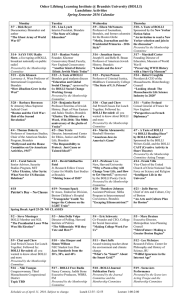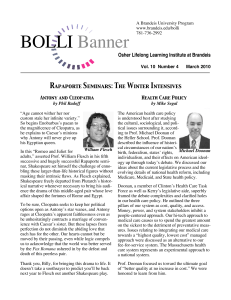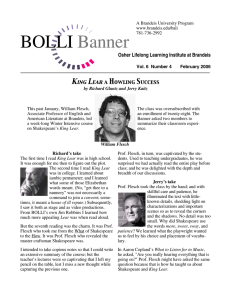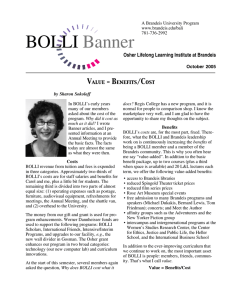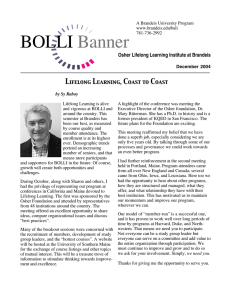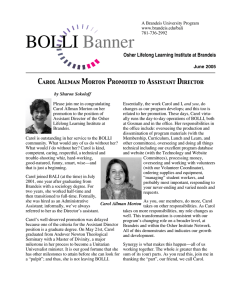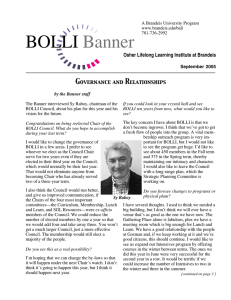BOLLI Banner B T
advertisement
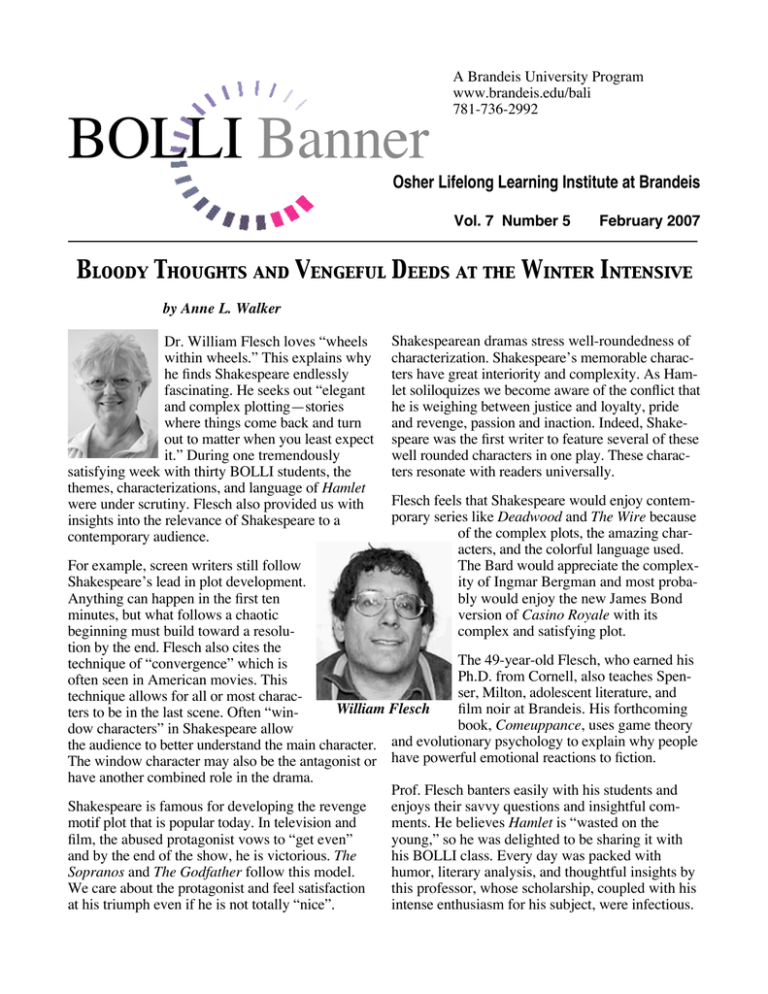
BOLLI Banner A Brandeis University Program www.brandeis.edu/bali 781-736-2992 Osher Lifelong Learning Institute at Brandeis Vol. 7 Number 5 February 2007 Bloody Thoughts and Vengeful Deeds at the Winter Intensive by Anne L. Walker Dr. William Flesch loves “wheels within wheels.” This explains why he finds Shakespeare endlessly fascinating. He seeks out “elegant and complex plotting—stories where things come back and turn out to matter when you least expect it.” During one tremendously satisfying week with thirty BOLLI students, the themes, characterizations, and language of Hamlet were under scrutiny. Flesch also provided us with insights into the relevance of Shakespeare to a contemporary audience. Shakespearean dramas stress well-roundedness of characterization. Shakespeare’s memorable characters have great interiority and complexity. As Hamlet soliloquizes we become aware of the conflict that he is weighing between justice and loyalty, pride and revenge, passion and inaction. Indeed, Shakespeare was the first writer to feature several of these well rounded characters in one play. These characters resonate with readers universally. Flesch feels that Shakespeare would enjoy contemporary series like Deadwood and The Wire because of the complex plots, the amazing characters, and the colorful language used. The Bard would appreciate the complexity of Ingmar Bergman and most probably would enjoy the new James Bond version of Casino Royale with its complex and satisfying plot. For example, screen writers still follow Shakespeare’s lead in plot development. Anything can happen in the first ten minutes, but what follows a chaotic beginning must build toward a resolution by the end. Flesch also cites the The 49-year-old Flesch, who earned his technique of “convergence” which is Ph.D. from Cornell, also teaches Spenoften seen in American movies. This ser, Milton, adolescent literature, and technique allows for all or most characfilm noir at Brandeis. His forthcoming William Flesch ters to be in the last scene. Often “winbook, Comeuppance, uses game theory dow characters” in Shakespeare allow and evolutionary psychology to explain why people the audience to better understand the main character. have powerful emotional reactions to fiction. The window character may also be the antagonist or have another combined role in the drama. Prof. Flesch banters easily with his students and enjoys their savvy questions and insightful comShakespeare is famous for developing the revenge ments. He believes Hamlet is “wasted on the motif plot that is popular today. In television and young,” so he was delighted to be sharing it with film, the abused protagonist vows to “get even” his BOLLI class. Every day was packed with and by the end of the show, he is victorious. The humor, literary analysis, and thoughtful insights by Sopranos and The Godfather follow this model. this professor, whose scholarship, coupled with his We care about the protagonist and feel satisfaction intense enthusiasm for his subject, were infectious. at his triumph even if he is not totally “nice”. OLLI in the Sun by Joan Kleinman “East is East and West is West and never the twain shall meet,” wrote Rudyard Kipling. But East Coast Osher did encounter West Coast Osher when I attended classes at OLLI UCSD (University of California at San Diego) this winter on a trip to La Jolla, CA. With over 30 courses and more than 20 lectures available for the winter term, you may attend any and all classes you’d like. Yes, you read that correctly. It’s Tuesday and you’re in a literary mood, join the Best Short Stories class. Fascinated with world politics, come to Friday’s Great Decisions and Foreign Policy class on the Middle East. Right side of your brain need a workout? Attend Wednesday’s session of Western Music from the Baroque to the 20th Century. The word “lottery” is unknown here. Easy? Not quite. While a course does convene regularly for five two-hour sessions in a term, it meets every other week. So you have to know if it’s an A week or a B week. Confuse the two and your short story class will have morphed into The U.S. in World War Two. Begun as The Institute for Continued Learning in 1974, it changed its name upon receipt of an Osher grant in 2004. Home is a small one-story wooden building, nestled in a cluster of such structures forming the UCSD Extension Department. Classes are held five days a week, year-round, in a morning or early afternoon time block. For lunch, folks can bring their own, visit a kiosk café adjacent to the Osher building, or go to a nearby student cafeteria. Most eat and socialize at patio-style tables on the outdoor courtyard, even in January (sigh!). With its balmy California climate, OLLI UCSD attracts a species rarely, if ever, seen at BOLLI: the snowbird. Many seasonal residents populate the winter term. Familiar BOLLI faces this winter were Steve and Bernice Baran, Eileen Mitchell and Ed Goldberg, and my husband, Allan, and myself. My backpack stayed light. No multi-page syllabi or weighty handouts, just a notation in the catalogue of the required book (if any) and what pages to read for each session. Most courses are peer-facilitated, ranging from the smaller discussion-oriented to the larger, pure lecture-type courses that may have no homework at all. Class size varies hugely; and because of the flexible attendance policy, the feeling in each class is not as intimate as I am used to. Augmenting the program, a “Distinguished Lecturer” series draws experts from many fields as guest presenters. But, despite logistical differences, the two OLLIs share the most essential ingredient for a successful program: a group of lively, interesting, and inquisitive people eager to learn in a friendly, stimulating atmosphere. The BOLLI Banner is published by the Banner Editorial Committee: Richard Glantz, Publisher Tamara Chernow, Co-Editor Charles Raskin Carole Grossman, Co-Editor Katherine Raskin Carol Shedd, Secretary Naomi Schmidt Len Heier, Photographer Email us at: BALIBanner@aol.com Next deadline: 3/2/07 Banner archive: www.brandeis.edu/programs/bali/Banner%20Archive/index.html Vol 7 Number 5 -2- February 2007 Who’s on First by Katherine Raskin In the 2006 Fall semester a course was offered entitled New Voices—Looking at Recent Immigration Through Fiction. This interesting course was developed jointly by six new SGLs: Bernice Baran, Elaine Dohan, Carole Grossman, Dianne Hoaglin, Sandy Traiger, and Anne Walker. Teaching an interesting subject through literature was a creative approach, and the course turned out to be exceptional. present. All of the facilitators attended every class which was essential to making the classes work so well. They became time-keepers, informed the facilitator when people wanted to speak, engaged in the discussions, and then met to review each session. They were very open to each other’s criticisms to learn what worked and what didn’t. The classes were well attended, and almost everyone participated in each discussion. We all learned a great deal about immigration, how difficult it is to assimilate into our culture without the knowledge of English, and how people from different cultures have strong ties to the customs of their countries of origin. The course celebrated the new voices of four Asian-American novelists from All of the SGLs are lovers of literature. They had Korea, China, Vietnam, and India. The short stories been in classes together but not all knew each other included other immigrant groups from well before working on the curriculum for Mexico, Russia, and Africa. Participants this course. The six members decided that CLASSROOM presented brief biographical sketches of if they could team teach, it would be easithe authors studied; supplementary reader, less intimidating, and much more fun. HIGHLIGHTS ings about immigration were offered on After agreeing on the timely theme of iman eBoard. migration, they began to read novels and short Not only did we hear about new immigrant voices stories written by contemporary immigrants to the in literature, but we heard from six new voices United States. They looked for talented authors of relatively unknown works. Each read many novels from BOLLI who led us into a new experience of a jointly taught course. It was a wonderful adventure and short stories during the one-year planning process, and together they selected four novels and for all of us, including the facilitators. Hopefully this course will be offered again in the future so that four short stories. They met regularly to write more BOLLI members will have the opportunity to questions and discussion topics for each selection participate in this successful experiment of a course so that the classes would have structure. Each being led by multiple study group leaders. selected the novel or short stories she wanted to BOLLI Adventures for Spring 2007 Sackler Museum at Harvard March 22th, Thursday Docents will conduct tours of two exhibits: Cultivating Virtue: Botanical Motifs and Symbols in East Asian Art and Classified Documents: The Social Museum of Harvard University, 1903–1931. Institute of Contemporary Art April 12th,Thursday A tour of the exciting new museum on the Boston waterfront including architectural highlights, wonderful views, 21st century art, and the current exhibition Super Vision. Broadmoor Audubon Sanctuary May 8th, Tuesday Walk outdoors with a naturalist on trails through wildlife habitats. We may see wildflowers and bluebirds in the meadow, nesting herons by the marsh, migrating spring warblers in the woods. Vol 7 Number 5 -3- February 2007 Memory Lane by Elaine Reisman Alzheimer’s Disease, a progressive, degenerative disease of the brain, has “come out of the closet.” It has become an acceptable subject for discussion, not only in the area of health, but in government and social planning as well. It is important to be informed and to recognize signs of Alzheimer’s in ourselves and in others. Early detection makes possible interventions which may slow down the progression of the disease. Over 4 million people in the U.S. have the disease. One in 10 people over 65 and nearly half of those over 85 have Alzheimer's. While memory loss is the hallmark of the disease, sporadic and short incidents of forgetfulness do not necessarily signify Alzheimer’s. We all have had experiences of walking into a room to get something and suddenly finding that we don’t know what we were looking for, or driving along and feeling as though we don’t know where we are. • • • • • • • • • • • memory loss, especially short-term memory frequent repetition of questions or statements difficulty performing tasks problems with language affecting articulation or word retrieval disorientation to time or place poor or decreased judgment problems with abstract thinking misplacing things or putting them in illogical places changes in personality, mood, and behavior loss of initiative wandering. These same symptoms may pertain to other forms of dementia. Numerous factors unrelated to dementia may result in similar symptoms. Therefore, a thorough evaluation should include a family and behavioral history, a complete physical with neurological exam, and current assessment for depression, side effects from medication, diabetes, thyroid problems, excessive use of alcohol, poor diet, vitamin deficiencies, or infections. There is no cure for Alzheimer’s, but there is much research on causes, medications, and genetic components. Current medical treatment a variety of drugs which can TO YOUR includes slow the progression of the disease, Generally, changes in the brain begin 20 years prior to appearance of symptoms. GOOD HEALTH particularly when started early. However, researchers concur that physical exercise Indications of Alzheimer’s Disease may and stimulating mental activity are at the top of their be subtle and vary in magnitude. The precursor list for preventing or counteracting the effects of the condition to Alzheimer’s is referred to as mild cognitive impairment. Most of the people who have illness. Diet is also emphasized. this condition will develop Alzheimer’s within five years. When symptoms appear, or if there is suspi- Attention is also being given to stress on the family, cion of dementia, it is important to get an evaluation particularly the caregiver. Educational programs and support groups are increasing partly because from a neurologist. Behavioral and neurological testing are important although there still is no defin- the strain frequently results in death of the caregiver itive diagnosis for Alzheimer’s short of an autopsy before the death of the afflicted person. of the brain. A good resource is the Massachusetts Alzheimer’s Alzheimer’s can show up in loss of cognitive abili- Association, at www.alzmass.org and at 311 ty or emotional changes, and it is characterized by a Arsenal St. in Watertown, 617-868-6718. They are consistent pattern of several of the following symp- committed to providing support services, information, educational programs, research, and advocacy. toms: Vol 7 Number 5 -4- February 2007 Equity vs. Fairness in Estate Planning by Gerald P. Tishler You have three adult children: Adam, an engineer who is married with four children; Eve, who has already amassed a large net worth from commodities trading and plans to remain single; and Job, a sculptor, whose wife left him to care for their handicapped daughter. You and your spouse are in your early 70s, healthy and well off financially and are preparing to visit your lawyer to revise your estate plans. You both want to do the right thing by your children and grandchildren, but what’s “right?” There is another way, and that is the so-called “spray” trust. That enables your trustee to allocate both income and principal where it’s needed, in accordance with some ascertainable standard, even if it’s only a general one, such as the “health, education, comfort and welfare” of the beneficiary. In that way, the needs of Job’s daughter can take financial precedence over Eve, who doesn’t need any income from her parents’ trusts. It’s a great solution, but it does generate its own problems. Adam, for example, may perceive himself to be much more industrious than his sculptor brother, and deserving of support to send his four kids to private colleges. Or Eve, insecure without a pile of money, may feel that she is entitled to a third of everything and would rather receive it and then help out her nieces and nephews at her discretion. What’s more, Job might resent a trustee making these allocations. So, what does a conscientious grandparent do to achieve the right result without precipitating internecine warfare? This is one of the few areas of estate planning that is not primarily tax-driven. There is no right or wrong. It should be entirely your decision, with your lawyer simply outlining the options, not directing you. Here are some of the alternatives, The answer is to talk it through with your putting aside the technical structure of trusts and the like. You could provide that your ELDER LAW children before you see your lawyer to obtain their buy-in to the concept, and to estate would be divided per capita among your children and grandchildren, which means that also obtain their suggestion on who would be a each of them that survives you takes an equal share, good trustee. Maybe there won’t be agreement 1/8th in the example above. This is mathematically among them, so you could discuss a “Plan B”, symmetrical but treats all generations alike. Alterna- perhaps dividing the income equally among the tively, you could provide that your estate be divided three children, but giving the trustee discretion to per stirpes, which means that each of your children spray a small proportion of the principal each year to where it’s needed. There are other variations; but take an equal share. For example, if Adam doesn’t survive you, each of his four children take a 1/12th if your kids support the concept, you will have left share (one quarter of one third). This disposition is them a greater legacy than the trust funds. quite common, but doesn’t take into account the special circumstances of Job’s daughter, or Adam’s [Note: this marks the appearance of a new column devoted to elder law. This article was written by a new member, large family, in relation to Eve’s financial indepen- Gerry Tishler, recently retired from Brown Rudnick. Please dence. So, while per capita and per stirpes distribu- let the Banner know if you would like to see more articles of tions may be equitable, are they fair? this nature.] “How do I look?” “Is my hair OK?” “Smile!” This was the chatter in the Gathering Place last November when 180 members stepped up to be photographed for the forthcoming BOLLI Face Book. Thanks to photographers Barry David, Charlie Raskin, and Harry Veron for their cheerful, tireless work. For those not yet photographed, another opportunity will be scheduled during the middle of the Spring term. Vol 7 Number 5 -5- February 2007 Stepping Up For a Colleague by Sandie Bernstein When Bernie Reisman was retiring as Director of the Hornstein Program of Jewish Communal Service, he envisioned the creation of a life-long learning program held, above all, in a supportive communal setting. This fall when Bill Rachlin became ill after the first session of his BOLLI anatomy and physiology course, You: the Owner’s Manual, the system was tested. Without hesitation, fellow physician Ed Goldberg, appeared that very morning to substitute for Bill. He was succeeded by BOLLI members Dr. Peter Brem, Dr. Michael Berger, Dr. Bernie Geffen, and by Brandeis graduate student Tracey Seier. Each one stepped up to the plate to teach, aided by Bill’s prepared readings and slides. When Ed Goldberg returned to teach the Endocrine System he said, “In substituting, I felt that I had benefited the most through my preparation. I learned an unbelievable amount about the complexity of this feedback mechanism, the newest data, and how it relates to our daily lives.” He shared his enthusiasm with the class through fascinating analogies and real life cases. As he awaited surgery some eight weeks later, Bill noted, “Special thanks are due to Myrna Cohen, whose idea it was to find substitute leaders, to Sharon and Carol, who performed with their usual efficiency, and to the students who stuck with it when we were so rudely interrupted.” Hail to the BOLLI spirit that lives and its system that works when tested. We all benefited. SID Students Enjoy American Thanksgiving Shutterbugs Seek Professional Advice by Judy Cohen by Richard Glantz Lou Jones captivated thirteen BOLLI members with his tales of how a commercial photographer makes a living. photo by Judy Cohen The Friday after Thanksgiving was a special experience for my family and for six SID students. We shared our tradition of Shabbos, and the students shared stories of their families and their faraway homes. Our understanding and respect for each other grows and is precious. Top row: Uttam Babu Shrestha (Nepal), Shamila Daluwatte (Sri Lanka), Maria Nandago (Uganda) Middle row: Lucy Njagi (Kenya), Sujata Shrestha (Nepal) Bottom row: Gul Shamim (Pakistan), Judy Cohen Vol 7 Number 5 It is more than equipment— Lou shoots both film and digital in large, medium, and 35mm. formats. It is more than the studio—the doors to his high-ceilinged Roxbury studio open so wide a car can pull in to have its picture Lou Jones taken. It is more than creativity and attention to detail —his near-abstract rendering of window shades for a forthcoming magazine ad will stop any casual pageflipper. In my opinion, Lou’s success derives from his absolute devotion to his craft—Lou lives and sleeps in his studio. Indeed, we were never sure whether the living room and the kitchen in Lou’s studio were props or his actual living room and kitchen. -6- February 2007 4-Class Pilot Task Force Report by Nancy Rawson and Ron Levy At the December meeting of the BOLLI Council, Nancy Rawson presented the 4-Class Pilot Task Force report and the results of its survey. Of the 387 active members, 237 responded, a gratifying return of over 60%, with many offering additional useful anecdotal comments. The returns were about evenly divided between those who preferred the 3-class schedule and those who preferred 4 classes. Under the 3-class schedule, over 80% of the respondents said they would be willing to take a first or last period class; under the 4 class schedule, only about 50% expressed such willingness. Additional analysis of Fall 2005 (3 periods) and Fall 2006 (4 periods) attendance showed that in both cases, the first and middle periods were essentially filled and the last periods, particularly the 4th period in Fall 2006, were the least popular. The two most negative aspects of the new schedule were the difficulties of the early morning and late afternoon commutes (though many found them less difficult than expected, and 77% found their commutes acceptable), and the unacceptably long wait between classes if one ended up with one class in the first period and one in the fourth. On the positive side were the smaller class sizes (average 19 vs. 23) and the greater number of course offerings (36 vs. 30). Some members felt that there was less opportunity for socialization with the new schedule because friends’ schedules did not overlap as much as previously. Others felt it gave them more time to socialize between classes. The comments received included the above concerns, suggestions that a more comfortable waiting area and a quiet place to study would be nice, and various suggestions for ways of improving the time and activities between classes. It was also suggested that there might be adjustments to the lottery rules which would spread the advantages and disadvantages of the expanded schedule more evenly. On balance, the Task Force recommended that the new schedule be continued, its advantages out-weighing its disadvantages. The Task Force made the following recommendations to address some of the issues: • Run a shuttle bus at appropriate times between Gosman, the upper campus, and the library • Provide an area devoted to quiet study and reading • Plan additional activities for the middle periods, including encouraging greater use of Brandeis athletic facilities • Vary scheduling so individual SGLs and specific courses are assigned different time slots and days from those in a previous semester • When the lottery is computerized, consider weighting requests according to a member’s previous “good” or “bad” luck. The Council commended the Task Force for its thorough and useful report and will take under consideration its recommendations. It also appreciated the cooperation members showed in completing the survey and making constructive suggestions. Task Force members were Chair Nancy Rawson (Membership), Ruth Antonoff (Resource), Marty Nichols (Curriculum), Sandy Traiger (Lunch and Learn), and Carol Allman-Morton (Asst. Director). Incentives to be a Study Group Leader ➨ First choice of any class you wish to attend ➨ Membership fee is waived (multiple SGLs leading a course split the one waiver) The shuttle fee is not waived Vol 7 Number 5 -7- February 2007 Calendar of Campus Events compiled by Charles Raskin SLOSBERG MUSIC CENTER Check with the box office (781-736-3400, option 5) for tickets Remember, BOLLI members receive a substantial discount Mar. 4 (3 P.M.) Catch a Rising Star! Neal Hampton, conductor Featuring the winners of the 2006 Brandeis and Wellesley concerto competitions: • (Kate Housman), Strauss Horn Concerto No. 1 • (Arum Chun), Beethoven Piano Concerto No. 2 mvt 1 • (Heather Rich), Strauss Four Last Songs: Beim Schlafengehn • (Aubre Carreon-Aguilar), Mozart aria Vado, ma dove Mar. 9 (8 P.M.) Big Wolf Jazz Concert Bob Nieske, director Bob’s 10-piece Big Wolf Project continues the development of jazz composition for larger groups along the historic path set by composers Gil Evans, George Russell, and Jimmy Giuffre. Bob’s compositions are intelligent, challenging, and accessible. Mar. 16 (8 P.M.) Evan Hirsch: A Fantastic Journey Solo recital of evocative music from three centuries • Haydn Sonata in D Major, Hob. XVI:33 • Schumann Fantasie, Op. 17 • Messiaen Vingt Régards sur l’Enfant-Jésus Mar. 10 (8 P.M.) Graham Patten Violin Recital • Kreisler Recitativo and Scherzo, Op. 6 • Paganini Caprice 13, Op. 1 • Bach Partita no. 2 in D Minor • Brahms Sonata No. 1 in G Major, Op. 78 • Smetana Piano trio in G Minor, Op. 15 Mar. 18 (7 P.M.) Brandeis Chamber Choir James Olesen, director A cappella music of the ages, from the early 1500s to the present day Mar. 17 (7 P.M.) Lydian String Quartet Joaquin Turina La Oraciòn del Torero Villa-Lobos Quartet No. 6 Ravel String Quartet Mar. 25 (7 P.M.) SERP Trio The Senior Recital and final performance by our outstanding music scholarship string and piano trio: Graham Patten, Sidney Cohen, and Joshua Klein Mar. 24 (8 P.M.) Lydian String Quartet (and guest artists) New works by eight Brandeis graduate composers SPINGOLD THEATER 781-736-3400, option 5 Amazones: The Women Master Drummers of Guinea Mar. 3 (8 P.M.) A thrilling evening of dynamic African drumming, song, and dance that has been hailed by critics as “a heavenly outpouring of throbbing jubilation, forceful uplifting beats, and pounding enthusiasm that is hypnotic”. West Africa’s Les Percussion de Guinee is widely recognized as one of the most extraordinary drumming ensembles in the world. It has been, by custom, all male. Now, for the first time, these famous men share the stage with women master drummers, the Amazones. Admission: $10 for BOLLI members ROSE ART MUSEUM GOLDFARB LIBRARY Rapaporte Treasure Hall Mar. 1 (7 P.M.) Clare Rojas (via satellite) The Museum presents the Clare Rojas catalogue and artist-in-residence award Vol 7 Number 5 Mar. 3 (2 P.M.) Gallery Talk A talk on the exhibitions with Director Michael Rush -8- Mar. 7 (noon) Lydian String Quartet Same program as Mar. 17 (Slosberg) Admission: free February 2007


